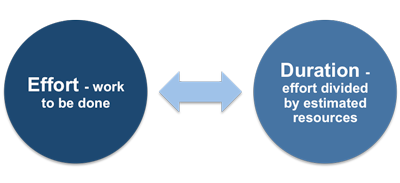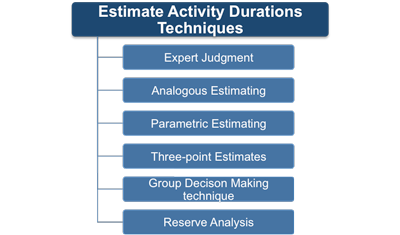Estimating the Time Required
This step involves estimating the amount of effort required for each activity and then calculating the total duration. Effort is the work to be done whereas duration is this figure divided by estimated resources.
 |
For example,
If there is a requirement to build one hundred meters of wall and a bricklayer can build 5 meters of wall in a day.
The duration of the task can be calculated by dividing the length of the wall by the number of bricklayers that will be assigned to the task. Then five bricklayers could be expected to complete the task in 4 days.
 |
All estimates, are to some extent uncertain at the beginning of a project and need to be progressively updated as you gain a better idea of how efficiently work is being done and exactly what resources you have available. You can check out the complete range of Project Management PDF eBooks free from this website.
The time required to complete an activity depends on the resources assigned to it but there are some limitations to this. For example,
Suppose it will take one operator with an earthmover four days to dig the foundations of a building. It is tempting to believe that two operators with an earthmover each could do it in two days.
However, this assumption does not take account of the fact that they would need to spend time coordinating their efforts and would probably keep getting in each other's way, greatly reducing their individual efficiency.
When assigning additional resources to an activity, always consider the possibility that it might reduce the overall efficiency and productivity. Most activities have a threshold beyond which assigning additional resources does not reduce the duration because of the additional overhead of communication and coordination.
The resource calendar, finalized (or modified) during activity resource estimating, contains the type, quantity, availability, and capability of each resource, including the skills of a human resource, which must be considered during activity duration estimating.
Capability and quantity of available resources, both human and material, can affect the activity duration estimate.
 |
Expert judgment using historical information from similar projects can provide duration estimates. It can also be used to reconcile different estimating methods, and to estimate the whole duration of an activity when not enough information is available.
This technique can be used to estimate some parameters to be used in other methods. For example, what percentage of the original activity duration estimate should be used as a contingency reserve, and in comparing an activity to a similar activity in a previous project during analogous estimation?
Analogous estimating techniques estimate the duration of an activity based on the duration of a similar activity in a previous project. The accuracy of the estimate depends upon how similar the activities are and whether the team member who will perform the activity has the same level of expertise and experience as the team member from the previous project.
Analogous estimating is typically a form of expert judgment that is most reliable when the previous activities are similar to the current activity and when the team members preparing the estimates have the necessary experience.
This is a simple technique used to calculate the activity duration when the productivity rate of the resource performing the activity is available. You can use the following formula: Activity duration = Units of work in the activity / Productivity rate of the resources.
For example,
If a groundwork gang consisting of six operatives plus their equipment can lay 50 square meters of reinforced concrete in a day, the duration calculation can be performed as follows:
Activity duration = 250 square meters / (50 square meters/day) = 5 days
 |
This technique relies on the statistical relationship that exists between a series of historical data and the variables in question. When this data is being drawn from a large body of historical data taken from similar projects, then it can yield accurate estimates.
It provides several advantages as an estimating technique for example they:
• Allow estimates to be prepared in much less time than required by more detailed techniques.
• Require quantitative inputs that are linked to algorithms providing quantitative outputs. All costs are traceable.
• If two estimators input the same values for parameters, they will get the same resulting cost.
• Provide a consistent estimate format and estimate documentation.
• Provide costs for a range of input values, extrapolating to derive costs for projects of a different size or nature.
• Highlights the design parameters used.
• Able to provide key statistical relationships and metrics for comparison with other projects.
The disadvantages of this method are:
1) Models will not exist for activities until there is a sufficiently large experience base for the activity. Basing estimates on work that is only vaguely comparable will yield inaccurate estimates.
2) Physical parameters, for example 'number of bricks laid', 'area of trees cleared' or 'number of widgets produced' are far more meaningful than non-physical parameters for example, the 'number of lines of code' in a software project.
3) There may be changes in technology or working practices. For example, an electrician's productivity is constrained by the speed at which he can 'chase out' channels in the walls in which to lay cables, a job that used to be done with a hammer and chisel. The invention of an affordable power tool to do this job resulted in a significant increase in the amount of cable that could be laid per day.
Three point estimates address the issue of uncertainty in estimating the activity duration. This uncertainty can be calculated by making a three-point estimate in which each point corresponds to one of the following estimate types:
1) Most Likely Scenario (ML)- the activity duration is calculated in most practical terms by factoring in resources likely to be assigned, realistic expectations of the resources, dependencies, and interruptions.
2) Optimistic Scenario (O) - is the best-case version of the situation described in the most likely scenario.
3) Pessimistic Scenario (P) - is the worst-case version of the situation described in the most likely scenario.
 |
We then find the average, but we first weight the Most Likely estimate by 4. The formula is (O + (4*ML) + P) / 6. We must divide by six because we in effect have six different estimates (although three of these estimates are the same number). This is because we are averaging (O + ML + ML + ML + ML + P) / 6.
Here's an example.
A roofing contractor is replacing all of the tiles on the roof of a house. He estimates that the job will take his team 10 hours based on the expectation that they will need to replace some of the underlying timbers. This is his Most Likely Estimate.
If none of the timbers need replacing then the job will take 7 hours, this represents his Optimistic estimate.
If most of the timbers need replacing then the job will take 16 hours, this represents his Pessimistic estimate.
 |
This formula is most useful in estimating time or cost of activities for projects that are especially unique, such as in research and development where there are many unknowns.
This step should include incorporating a time cushion into your schedule; this cushion is usually called a contingency reserve, time reserve, or time buffer. It's purpose is to accommodate the possibility of schedule risks. One method of calculating the contingency reserve is to take a percentage of the original activity duration estimate, although it can also be estimated by using quantitative analysis methods.
When more information about the project becomes available, the contingency reserve can be reduced or eliminated. Usually, while estimating for large projects, managers would like to keep a buffer of 5% or so of the total estimate for the project to account for project schedule risks, like delays in procuring hardware or unexpected personnel problems.
You may also be interested in:
Managing the Project Schedule | Defining the Project Activities | Sequencing the Project Activities | Estimating the Resources Required | Estimating the Time Required | Developing the Project Schedule | Controlling the Project Schedule.
|
|


